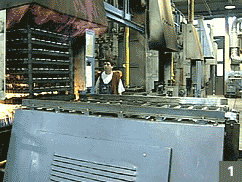 |
 |
 |
| Loading of the heat treat oven |
 |
   |
|
 |
Heat Treat.
Throughout the rugged, daily usage the crankshaft is exposed to extremely high forces. Both, crankshaft and connecting rod, are subject to a heat treat process at almost 1000°C after the initial soft machining stage.
This process modifies the crystal structure of the surface, giving the component the increased wear resistance required.
|